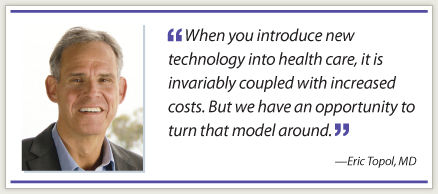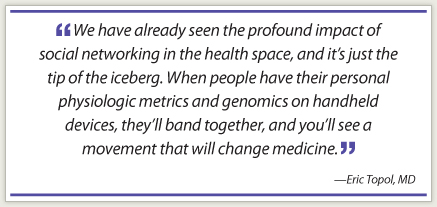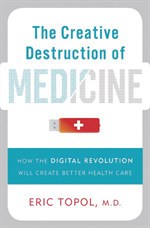According to nationally regarded cardiologist and geneticist Eric Topol, MD, Chief Academic Officer of Scripps Health, the next frontier of the digital revolution can create exponentially better health care. Dr. Topol, who is also Director of the Scripps Translational Science Institute and Professor of Genomics, The Scripps Research Institute, recently shared his thoughts with The ASCO Post on an unprecedented transformation in medicine, as described in his recently  published book, The Creative Destruction of Medicine: How the Digital Revolution Will Create Better Health Care (see book review). Here he discusses issues of value and cost in health care, the problems inherent in mass screening efforts, “individualized” vs “personalized” medicine, and how future innovations may be introduced to our health-care system.
published book, The Creative Destruction of Medicine: How the Digital Revolution Will Create Better Health Care (see book review). Here he discusses issues of value and cost in health care, the problems inherent in mass screening efforts, “individualized” vs “personalized” medicine, and how future innovations may be introduced to our health-care system.
Radical Innovation
Congratulations on your new book. It’s quite a provocative title; what was the inspiration?
The title simply captures the extraordinary opportunity we have to vastly improve the way we think about and practice medicine. The term “creative destruction” denotes a transformation that accompanies radical innovation. But this transformation is not likely to emanate from the medical community, the traditional way innovation jumps forward. In the current era of social networking, the transformation will likely come from a convergence of technology and consumerism, especially in the cancer space, which offers the most near-term opportunity for positive change.
As one example,when we have a tumor biopsy or tissue sample, it solely gets put in formalin, then fixed in paraffin, which is completely unacceptable. We need frozen tissue so we can rapidly conduct exome or whole-genome sequencing and use it to customize the right care for the individual’s driver mutations of a particular cancer. We have this technology; however, we have a challenge getting surgeons, pathologists—basically the whole oncology community—to switch to frozen samples. Of course, this is just one of many “rules” that need to be broken in the oncology sector.
Value and Cost
The health-care debate seems to get mired in issues of value and cost. How can we make systemic improvements given our limited resources?
One of the steadfast rules is that when you introduce new technology into health care, it is invariably coupled with increased costs. But we have an opportunity to turn that model around by being able to track physiologic metrics, genomic sequences, and advanced imaging modalities. By making medicine more precise, these advances can markedly reduce costs while improving care. The convergence of digital technology and consumerism will provide real, actionable data attached to specific health needs, which will in turn drive costs down by eliminating the waste involved in population-based medicine.
Screening and Individualized Medicine
Many in the oncology community believe that if we could replicate the mass screening efforts that are routine in breast and prostate cancer for application in other cancers, it would have a large impact on cancer mortality. What are your thoughts on screening?
The problem is that we don’t recognize the primacy and uniqueness of each individual. To date, the judgments we make and things we do in medicine—the old rules, whether it’s screening or therapy—are related to large populations, not individuals. Previously, we didn’t have the digital tools to do otherwise. But now we’re at this exciting inflection point, where we are able to zoom in on individual patient characteristics.
I never use the popular term personalized medicine, which to me denotes a concierge-style model. Instead, individualized medicine can define a patient biologically, physiologically, and anatomically, aggregating into what I call homo digitus—in effect, digitizing a human being for all the essential characteristics that make that person tick.
That approach will lead to far better outcomes going forward. For instance, we won’t have to have all women undergo routine mammograms after age 40 or 50, because a substantial proportion of women have no risk of developing breast cancer. We will ultimately identify that no-risk or extremely low-risk population, thus eliminating false-positives, biopsies, and the associated anxiety and attendant costs. In this case, mass screening disregards individual variability and promotes unnecessary medical procedures.
Further, once we have a diagnosis, with few exceptions we don’t screen that person to see what drug will work; we give the same drug to all people with that diagnosis. In diabetes, everybody gets metformin even though metformin doesn’t have any beneficial effect in 25% of those patients. However, in today’s medical mindset, we don’t take the patient off metformin; we simply add another drug, without screening to see if the drug is going to work. There are almost 400 million diabetics worldwide, so it’s a huge issue of wasteful medical resources. Again, that’s just one example of many.
Introducing Innovations
Considering that we have the tools to create “homo digitus” patients, how can we organize those tools to really make an impact on our vastly complicated system?
 By self-organization—there are groups out there already taking the lead with online patient empowerment communities. The people in these communities trust their peers more than their doctors, for one reason, because their peers have like conditions that are discussed freely. We have already seen the profound impact of social networking in the health space, and it’s just the tip of the iceberg. When people have their personal physiologic metrics and genomics on handheld devices, they’ll band together, and you’ll see a movement that will change medicine.
By self-organization—there are groups out there already taking the lead with online patient empowerment communities. The people in these communities trust their peers more than their doctors, for one reason, because their peers have like conditions that are discussed freely. We have already seen the profound impact of social networking in the health space, and it’s just the tip of the iceberg. When people have their personal physiologic metrics and genomics on handheld devices, they’ll band together, and you’ll see a movement that will change medicine.
Does a digital landscape fit into the strictures imposed by our limited financial resources?
Innovations moving forward cannot induce added cost pressures on the system. That would be untenable. We have a dual challenge with technologic innovation; it must improve health outcomes and significantly reduce expenditures. With creative destruction, you destroy very expensive methods with marginal benefit. In the United States, we spend $350 billion per year for prescription dugs, and we know at least one-third of that is total waste, offering no benefit or, even worse, inducing serious side effects.
Pharmacogenomics is a perfect way to destroy the old wasteful model of prescribing drugs. It’s very inexpensive to run genotypes, once we have basically cracked the code—knowing the specific variant allele(s)—for each drug.
We have inexpensive ways to drill down to the things that produce good outcomes. For instance, I’m a cardiologist and I don’t have to send a significant proportion of patients to a facility to have a formal echocardiogram, because I have a handheld high-resolution device that’s just as good as the hospital laboratory. Why do we send people to facilities for sleep studies that reimburse at $3,000 per night when the same study could be done in the person’s home for less than $100 and get the same data?
Closing Thoughts
Any last thoughts you would like to share?
I would like to see a transformation in which the medical community engages in the health-care revolution that will ultimately be consumer driven. We have a remarkable digital infrastructure including social networking that complements new opportunities to change the course of medicine, such as advances in genomics, biosensors, and imaging. There will be a superconvergence of human data capture that will give us the ability to digitally define the essential characteristics of each individual, not heterogeneous populations. I hope that my colleagues in medicine will acknowledge and embrace this unique opportunity to reboot medicine. ■
Disclosure: Dr. Topol reported no potential conflicts of interest.


